Ask ten people how to clean vinyl records, and you’ll undoubtedly get ten different answers. As the saying goes, “there’s more than one way to shine a penny”.
Some methods of cleaning vinyl records are more widely excepted than others, of course, but if we take the pragmatic route, I think we can safely conclude that each approach has pros and cons.
Record cleaning remains one of the most popular topics for Sound Matters readers, and we’ve covered our fair share of different approaches throughout the pages of this website.
Below, we’ve broken down each method to help you pick the best way to clean vinyl records based on your requirements and budget.
(There are links to more detailed reviews of each method included within each section).
1 – Good Old Fashioned Hand Cleaning
By hand cleaning, I don’t mean scrubbing with domestic soap and water. Despite many of the comments and videos available online, the general consensus across the industry is that this method presents many risks to your precious vinyl. Instead, when I refer to hand cleaning, I mean physically cleaning each disc by hand using a record cleaning solution and some form of a safe, soft cloth.
It’s well-documented that Sound Matters likes the GrooveWasher cleaning formula. (You can read more about how we use this product, here). Whichever formula you settle on, the pros and cons are as follows:
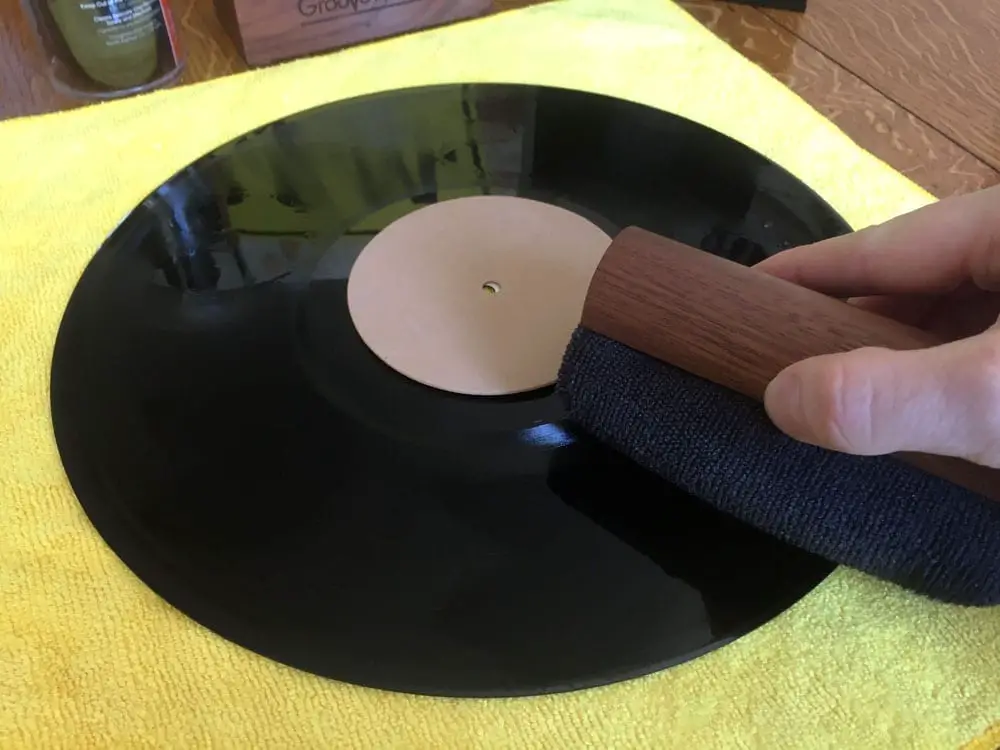
PROS: Hand cleaning is very affordable; you can generally get started with a good kit for as little as $20.
With the right formula and method, the old fashioned hand cleaning approach is also very effective when combined with a little time and patience. Lastly, hand cleaning kits take up very little space in your home.
CONS: Clearly, if you’re cleaning a large number of vinyl records in one go, then cleaning every disk by hand might not appeal.
To achieve effective results using this method, you must either keep your cleaning cloth (usually a microfiber cloth) very clean, or even better, replace them regularly. Failure to maintain a clean cloth will only result in moving dirt and dust around from one record to the next.
Price Bracket: ($10 – $85)*
(Sound Matters readers receive 10% off direct orders from GrooveWasher when using the discount code: SOUNDMATTERS10). (EU/UK Customers can use the same discount code at twelve-inch.com).
2 – Record Bath Systems
A bath-based system (like the well-known Spin Clean) helps to take some of the manual work away. Your records are ‘spun’ through a basin of distilled water with the help of two rollers and a pair of brushes. As the record spins, the dust and dirt is removed from the record. The additional record cleaning fluid is typically applied directly to the pads, which aid in cleaning.
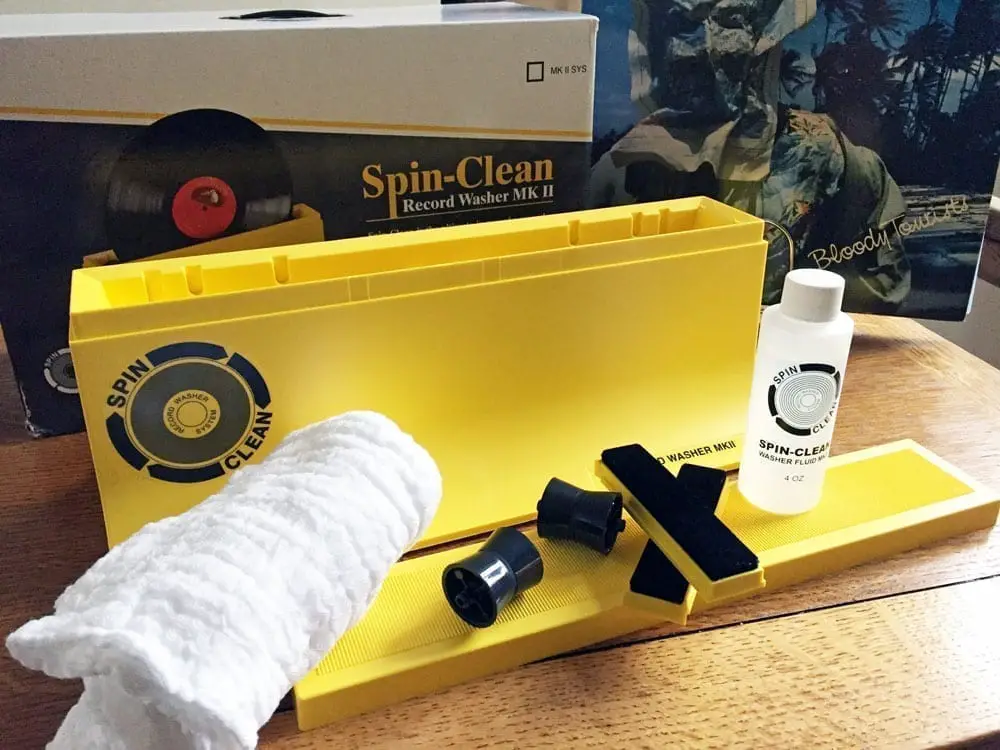
PROS: A record bath offers a very affordable way to batch-clean records.
You still have to physically move the record, but the basin setup allows you to go through a stack of wax much faster than any hand cleaning method.
CONS: To avoid cross-contamination of dirt from one record to the next, you’ll want to empty the basin and refill fairly regularly. Spin Clean (for example) state that each refill of the basin will clean up to 50 records, but in my experience, results are better if you cut this number in half.
Short of refilling the basin each time you clean ONE record, there’s always some risk of cross-contamination.
Price Bracket: $50 – $120*
3- Vaccum Record Cleaning Machines
If you’ve been at this hobby for some time and you’re the proud owner of a substantial collection, a record cleaning machine could be the right investment. A vacuum-based machine will suck out all of the applied record cleaning solutions, taking the dissolved dirt and dust away at the same time. If you can spare the cash, they work well!
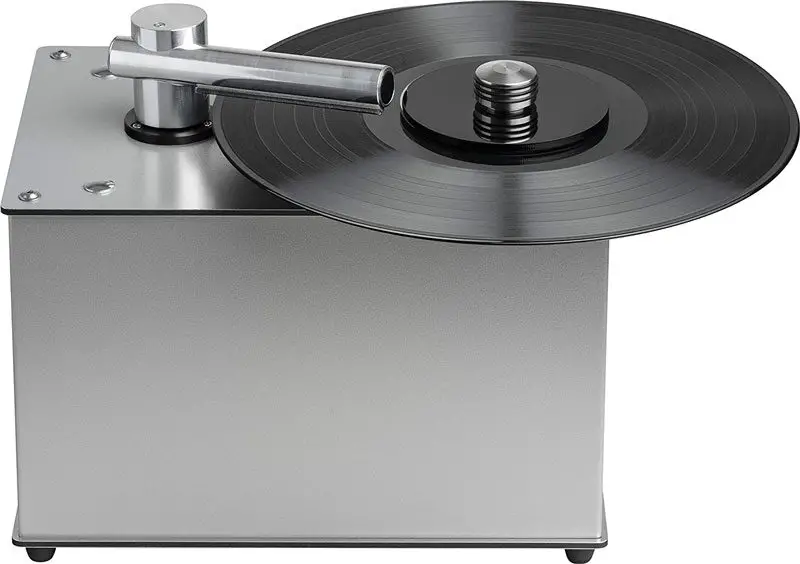
PROS: Unlike the previously mentioned methods, a vacuum record cleaner will physically remove the dissolved grime each and every time you clean a record. This, of course, greatly reduces the risk of cross-contamination. The cleaning results are very strong.
CONS: The cost, first and foremost. Typically, these machines cost around $400 dollars, so for many readers, that point alone will be a deal-breaker. Some companies produce hand-held vacuum tubes that you can attach to commercial vacuum cleaners, but this option, of course, is less convenient. Another point to consider here is the unit size and potential noise—new units are quieter than many older models, but the size and vacuum volume will vary from model-to-model. (My wife isn’t a fan of these things venturing into the living room, let’s just put it that way!)
Price Bracket: $499 – $1000*
VIEW PRODUCT
4 – Ultrasonic Cleaning (AKA Cavitation)
If you’ve got the funds and inclination, ultrasonic cleaning could be the most effective method of deep-cleaning vinyl record grooves. Many, in fact, single this process out as the most effective at cleaning stubborn, soiled records. Ultrasonic cleaning works by using high-frequency pressure sound waves to agitate a liquid, producing tiny cavitation bubbles. Lots of tiny bubbles produce high forces, which help to gently lift dirt, dust, and grime from the record grooves. Cavitation has long been popular in the jewelry industry; here are the pros and cons:
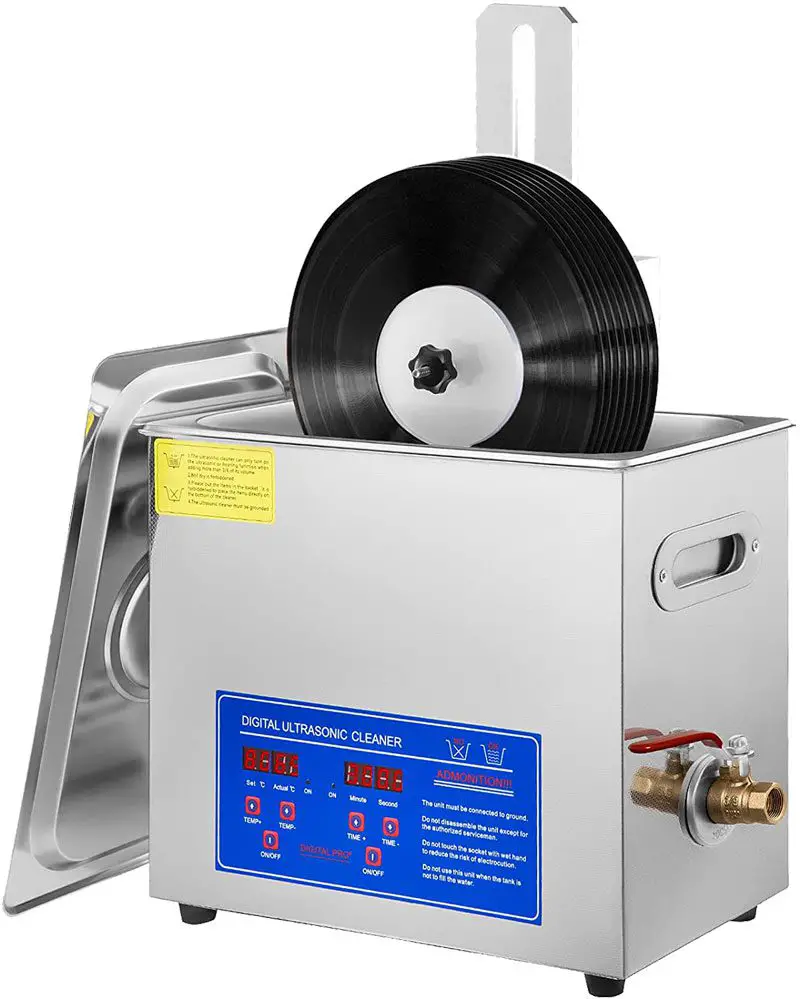
PROS: Highly effective at deep cleaning vinyl record grooves; the cavitation process literally shakes the dirt away. Unlike any other process, there is no risk to the record as no physical contact is made with it – no brushes or cloths to potentially drag the dirt particles across the surface of the record. Arguably, this process is more effective at physically removing entrenched grime than any other process we know.
CONS: Purpose-built ultrasonic record cleaners are often VERY expensive (we’re talking north of $2000 in some instances).
You can get around this by purchasing a separate ultrasonic cleaning bath that’s big enough to house 12-inch records, and then buying a 3rd party attachment to rotate the record. See one such example linked below:
Price Bracket: $260 – $2000+*
VIEW PRODUCT
5 – Carbon Fiber Brush
I’ve left this one until last, as while it does come under the category of record cleaning, realistically, we can file this one under the topic of record maintenance. A carbon fiber record brush is a tool you should use daily on your records (ideally before and after each spin of a record side). It will help to lift loose dust and prevent a much bigger problem down the road, but it will not remove built-up grime on older records, or the release agent present on most new records straight from the factory.
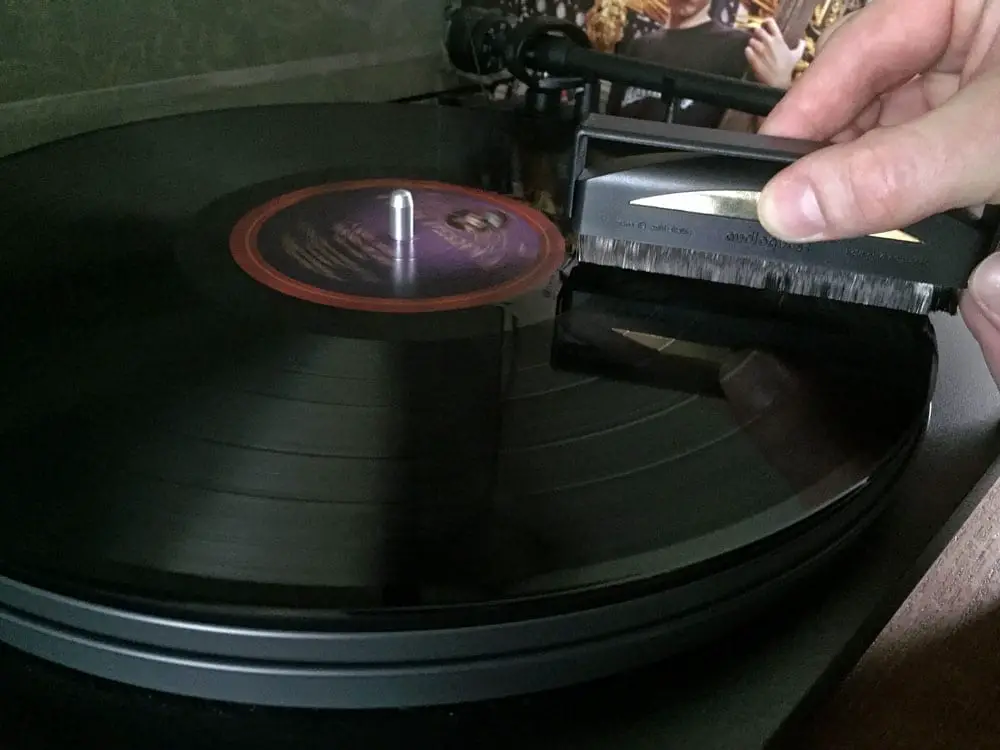
PROS: An affordable tool that prevents dust and dirt build-up and helps control static. Use this tool regularly and store your vinyl correctly to reduce your reliance on the above-mentioned wet cleaning methods.
CONS: Will not clean very dirty records.
Price Bracket: $14 – $30*
VIEW PRODUCT
Best Way To Clean Vinyl Records? The Bottom Line:
The cleaner your records, the better your listening experience will be—that much is clear to most people. However, as a closing statement, I would say this: your budget and cleaning method of choice should not restrict your ability to enjoy a vinyl hobby.
There’s a lot of snobbery out there. My advice – start with a hand cleaning kit and work your way from there. In many cases, of course, a record machine is overkill if the record is in reasonable condition; there are plenty of occasions where I’ve quickly cleaned a record by hand with perfect results—lugging out and setting up the record cleaner would’ve been a waste of time.
Lastly, don’t get too hung up on the idea of perfectly clean records. Yes, clean records sound great, but within reason, a little surface noise comes part and parcel with analog playback formats. In other words, don’t let the pursuit of vinyl nirvana get in the way of what’s ultimately important here: the music.
*approximate pricing
Over to You: What do you think is the best way to clean vinyl records? Let us know in the comments below:

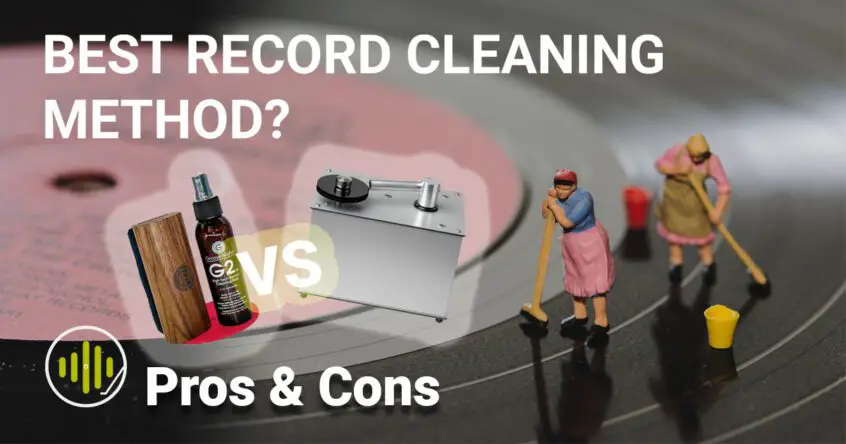


Disappointment: My chase of the “Nirvana” remains unsuccessful.
I use all of the methods above:
90% of all records are perfect. And Yes, even new UHQR (Hotel California) improved. In general I am very pleased.
But: All this effort still doesn’t get it all and some records can’t be saved.
And: I tested some of my favorite records on Degritter MK I. They deteriorated from 95% to 90%. Steps 6-10 fixed it.
Also: All the steps above did not fix my sins of my youth were I sealed not perfectly cleaned records with LAST.
I have to admit, the Degritter MKII gets rid of some of the noise that our Groove Washer can’t. Of course, it’s $3600. But for those who own ultra high end audio, it’s not much of a reach…
Some, but not all? How much improvement do you estimate? 10%?
How difficult is it to change tanks? How often do you need to exchange fluids?
AGREED with Andy, method No.1. It’s the connection to your vinyl collection,
in addition I’ll restore the sleeves and jackets. Immerse in the band’s history , history, credits, contributions to other bands.
Andy ‘thank you’ for your eloquent letter.
I know I’m going to receive some stick for this but: light scrubbing in a shallow sink of warm water with a couple of drops of Dawn dishwashing soap and a microfiber cloth. Lightly pad dry with a second microfiber cloth. When dry finish with a spray of 30% alchohol/70% distilled water and wipe with 3rd microfiber cloth. Works like magic. For the needle, dab very lightly with small square of mr. Clean magic eraser. Works like magic. Never damaged anything in 10 years.
My go to is the Groove Washer system, which is fantastic, however I am debating either Humminguru or iSonic as I will add ultrasound to by armamentarium.
I had an Okki Nokki which I bought 2nd hand and found it very good though the platter would work loose from time to time and had to be screwed back into place. I sold that to a record shop having upgraded to a 2nd hand Loricraft and that’s fantastic though not cheap. I’ve bought some really dirty looking records at Boot Fairs and cleaned them up and sound excellent.
Excellent article ! For me a combination of hand cleaning (with good brushes and fluids) + vacuum machine (Pro-ject VC-S2) is all I’ll ever need. I’ve found even the best ultrasonic machines perform best with a pre-clean.
Sorry, I meant to add that I just now finished building my ultrasonic record cleaner. So far, I am quite impressed with the results. The most surprising aspect, which has been commented on by others, is the honest improvement in the actual soundstage and definition! I use a 10L ultrasonic cleaner so that I can do up to 6 albums at once while still allowing about 1″ spacing between. I’m using the guidelines for the solution and the method based upon the excellent research paper that was posted a few years ago.
Several years ago I had also made my own vacuum RCM which has been very effective. I’ve found like others, that a combination of both for dirtier albums works really well.
Here are some pictures is anyone wishes to take a look – the last two pictures are the two RCMs:
https://photos.app.goo.gl/9ja3UKob7tppW4Y38
Cheers!
Please share a link to the research paper that you refer to.
Nice article as always…
But, try up to and beyond $4000 for ultrasonic record cleaning : )
you can buy a ultrasonic tank and device to turn the records at amazon for $500
I recently purchased Elma ultrasonic cleaning unit 6 liters with a cleaner vinyl pro lift and micron filter system. at first i was overwhelmed but it was easy to assemble and except instructions were applied. my wife had a collection of abused albums over 20 years old. currently cleaning five at a time in a solution of kodak and distilled water and alcohol. amazed at looking at the filter and how much grime was removed. very satisfied customer. currently rinsing for 20 minutes on low frequency. results are outstanding would highly recommend to other record collectors
That’s great, Mike. Ultrasonic cleaners are often touted as the most effective way to clean records. I’m glad you’re getting great results 🙂
Have been using method No.1 – Good Old Fashioned Hand Cleaning – happily with the Wax Wash product you mention. And the thing is, I really enjoy cleaning my records this way. In the way that I assume that most record/vinyl lovers love the ‘un-rushed’ ritual of selecting a song/record based on what mood they’re in in ‘that moment’, taking it out of whatever sleeve packaging it came with, checking out the graphics (even if you’ve seen them a thousand times before), glancing at or re-reading liner notes, placing the record on the turntable, lowering the tonearm and setting down the stylus in anticipation of that slight crackle – so too do I also enjoy taking my time to clean and care for an object that I have deep emotional connection to – with the anticipation – that the song I’m about to hear will just sound that much better. There is nothing like vinyl.
Completely agree. The ritual is a BIG part of the whole appeal.